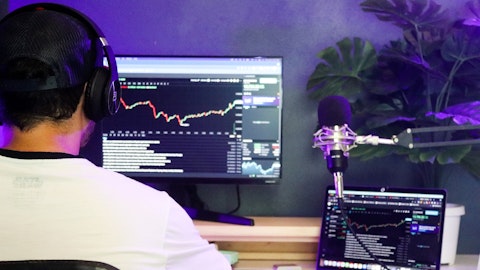IPG Photonics Corporation (NASDAQ:IPGP) Q3 2023 Earnings Call Transcript October 31, 2023
IPG Photonics Corporation beats earnings expectations. Reported EPS is $1.16, expectations were $1.02.
Operator: Good morning, and welcome to IPG Photonics Third Quarter 2023 Conference Call. Today’s call is being recorded and webcast. At this time, I’d like to turn the call over to your host, Eugene Fedotoff, IPG Senior Director, Investor Relations, for introductions. Please go ahead with your conference.
Eugene Fedotoff: Thank you, Rob, and good morning, everyone. With me today is IPG Photonics’ CEO, Dr. Eugene Scherbakov; and Senior Vice President and CFO, Tim Mammen. Let me remind you that statements made during the course of this call that discuss management’s or the company’s intentions, expectations or predictions of the future are forward-looking statements. These forward-looking statements are subject to risks and uncertainties that could cause the company’s actual results to differ materially from those projected in such forward-looking statements. These risks and uncertainties are detailed in IPG Photonics’ Form 10-K for the period ended December 31, 2022, and our reports on file with the Securities and Exchange Commission.
Copies of these filings may be obtained by visiting the Investors section of the IPG’s website or the SEC’s website. Any forward-looking statements made on this call are the company’s expectations or predictions as of today, October 31, 2023. And the company assumes no obligation to publicly release any updates or revisions to any such statements. For additional details on our reported results, please refer to earnings press release, earnings call presentation and the financial data workbook posted on the Investor Relations website. We will also post these prepared remarks on the website following the completion of this call. With that, I’ll now turn the call over to Eugene Scherbakov.
Eugene Scherbakov: Good morning, everyone. Our third quarter revenue was negatively impacted by a softer demand in industrial markets and a further decline in sales in China. Lower demand from industrial customers and reduced the amount of e-mobility applications drove revenue declines in cutting, welding and marking applications. We also continued to see strong competition in addition to soft demand in the flat sheet cutting market in China. But even with lower revenue, we are pleased with our operating performance this quarter and delivered gross margin improvement and earnings per share at the high end of our guidance. While the uncertainty in macroeconomic conditions continue to wait on capital equipment spending, customer in Europe, North America and Japan are increasingly uses a high-power laser for cutting.
We believe that laser adoption in these geographies is significantly behind China and this market remains less competitive with IPG holding a strong market positions. We’re also seeing the adoption of laser building technology in automotive and general industrial markets across many geographies. Laser welding provides high-speed precision and accuracy as well as low heat input and ability to join the similar materials. Our real-time welding measurement system is a great complementary technology for adjustable mode beam in the lasers and IPG welding [indiscernible] that provides a fast and reliable welding solutions for a broad range of applications across many different industries. Emerging growth product sales accounted for 42% of total revenue in the third quarter.
We saw a decline in AMB and high power pulsed laser related to lower demand on e-mobility applications due to decree investment EV battery capacity in China. We said in the past that the EV battery investment is likely to fluctuate quarter-to-quarter. Our production expansion projects can be very large in size and provide some lumpiness in our e-mobility services. As a result, some quarter, even years may be better than others. However, we expect EV investment cycle to continue, provides a great opportunity for IPG in the next 3 to 5 years. Adoption of electric vehicles still grows in China, Europe and North America, and battery manufacturers will need to build additional capacity to support higher EV sales. Also, Energy storage is growing and may potentially require even more batteries to support the transition to a sustainable energy in the future.
Our handheld welder sales continued to grow, driven by a rollout in Europe and LightWELD sales up in 4x the speed of traditional MIG and TIG welders and does not require extensive training. We are seeing as the high interest in the welding community and held 5 simultaneous live demonstrations of the device at the FABTECH show this year to satisfy this interest. We’re also still early on adoption curve and continue to promote LightWELD in welding market in U.S. and other geographies. We are also seeing a significant increase in demand for our lasers and 3D printing applications. Industry reports suggest that technology is being tested for manufacturing of consumer electronic devices. Growth in metal 3D printing technology has been shown that many had anticipated.
But it seems like there is a new catalyst that can potentially drive further adoption. 3D printing is using high-quality laser to melt metal powder to create parts and [indiscernible] a strong position in this market, providing the lasers with higher stability beam characteristics. We are recently introduced a new AM laser design, especially for additive manufacturing. This was [indiscernible] adjustable mode and can move from single mode to structure to multi-mode output or to 6x higher build up rates. Finally, sales in our medical business improved as expected after the inventory reduction by large customer in the prior quarter. Growth in medical continues to be driven by adoption of our laser system and consumable fibers which you are considering the gold standard in [indiscernible] applications.
We are also seeing strong growth in esthetic applications, which is a much larger market and our fiber laser technology is significantly more advanced compared to the traditional lasers used in medical and esthetic applications. And our goal is to gain market share by replacing this older technologies. We are working on multiple new opportunities to broaden our medical portfolio and to further grow the business so it becomes more meaningful contributor to IPG sales. In summary, I remain optimistic about the growth driven for our products and continued diversification of IPG revenue in the long term. We have introduced a new product for our laser cleaning and drying applications this year and promote our high-efficiency eco-lasers that help reduce the environment impact for our customers.
I would like to thank our employers for the strong contribution in the quarter. And I will now turn the call over to Tim to discuss financial highlights.

Timothy Mammen: Thank you, Eugene, and good morning, everyone. My comments generally will follow the earnings call presentation, which is available on our Investor Relations website. I will start with the financial review on Slide 4. Revenue in the third quarter was $301 million, a decline of 14% year-over-year. Foreign currency headwinds reduced revenue growth by approximately 2%. Revenue from materials processing applications decreased 15% year-over-year, while revenue from other applications was nearly flat. GAAP gross margin was 44.1%, an increase of 100 basis points year-over-year, which was driven by lower inventory provisions and reduced shipping costs and tariffs as well as an improvement in absorption of manufacturing costs as a percentage of sales.
On a sequential basis, gross margin continued to improve on lower revenue as we focused on reducing costs, managing inventory and improving manufacturing efficiency. Despite the headwinds to our revenue from a challenging operating environment, and reduced capital equipment spending worldwide, I am pleased with the resilience of our financial model and the company’s ability to improve margins and to continue to generate ample cash flow from operations to support current and future investments. FX headwinds also had a negative impact in the quarter. If exchange rates relative to the U.S. dollar had been the same as 1 year ago, we would have expected revenue to be $6 million higher and gross profit to be $4 million higher. GAAP operating income was $56 million, and operating margin was 18.5%.
Net income was $55 million or $1.16 per diluted share. The effective tax rate in the quarter was 19% and benefited from certain discrete items. Foreign currency transaction gains related to remeasuring foreign currency assets and liabilities to period-end exchange rates had a small positive impact on operating income of $400,000 or $0.01 per share. I’d like to remind you that last year’s results benefited from $22 million or $0.32 per diluted share gain on the sale of the telecom transmission business. Excluding the currency transaction gain, asset impairments and recovery of a restructuring charge related to our Russian operations as well as the gain on the sale of telecom business last year, operating expenses were nearly unchanged year-over-year.
Sequentially, operating expenses increased primarily in research and development and sales and marketing as we invested in resources to drive future growth while still controlling expenses. Moving to Slide 5. Sales of high-power CW lasers decreased 22% and represented approximately 40% of total revenue. Sales of ultra-high power lasers above 6 kilowatts represented 46% of total high-power CW laser sales. The decline in revenue was primarily due to lower demand in flat sheet cutting applications in China and Europe. We continue to see customers outside of China adopting laser technology, but demand has been impacted by the economic uncertainty with OEMs delaying purchasing and reducing inventories. Pulsed laser sales decreased 25% year-over-year due to lower sales in marking and solar cell applications.
System sales increased 4% year-over-year, with growth in LightWELD offsetting a decline in non-laser systems. Medium power laser sales increased 1%, driven by increased demand in welding and higher sales in 3D printing applications. QCW laser sales were down 4% year-over-year, and other product sales decreased due to lower revenue in advanced and telecom applications. Looking at our performance by region on Slide 6. Revenue in North America decreased 13%. We saw a strong growth in welding and cleaning applications as well as higher parts and service sales. However, this growth was more than offset by lower sales in cutting, medical, advanced and telecom allocations. In Europe, sales increased 3% and the region continued to perform well given weak — the weak macroeconomic environment.
Revenue growth was driven by welding and semiconductor applications. Revenue declined in cutting, marking and cleaning applications, which were impacted by lower industrial demand and destocking by some OEM customers. Revenue in China decreased 28% year-over-year as demand declined across most industrial applications, including cutting, welding and marking. Additionally, revenue was negatively impacted by competition in the flat sheet cutting market and lower demand in e-mobility applications due to a decline in new battery products — projects and delayed capacity expansions. Moving to a summary of our balance sheet and cash flow on Slide 7. We ended the quarter with cash, cash equivalents and short-term investments of $1.1 billion and no debt.
Our inventories continue to decrease sequentially, and we target further reductions in inventories in the fourth quarter. Cash provided by operations was $86 million and capital expenditures were $26 million during the quarter. We sold 2 buildings in the quarter, realizing $29 million in proceeds, which means net capital expenditures are just under $55 million year-to-date, well below the same period last year. While maintaining a strong balance sheet, we have been returning a significant amount of capital to shareholders through opportunistic share repurchases. We spent $46 million on share repurchases in the third quarter and approximately $160 million this year. Moving to our outlook on Slide 9. Third quarter book-to-bill was below 1 with macroeconomic uncertainty resulting in a project delays and reduced orders in all major manufacturing regions.
Leading manufacturing indicators in Europe are trending to the lowest level since the 2008 recession. While economic indicators in China are mixed, we believe the Chinese cutting market is down 20% to 30%, and the timing of an overall recovery in demand remains uncertain despite some government stimulus. Competition from Chinese manufacturers remains stiff. Additionally, project delays related to battery capacity expansion in China provide further uncertainty to the outlook. Although we have limited visibility into orders beyond fourth quarter, we continue to believe the battery investment in China should restart in 2024 as electric vehicle sales continue to increase. Investments in battery capacity outside of China is in the early stages and should increase in the next several years as well.
We also expect some benefits from government spending and onshoring activities to benefit industrial activity in the U.S. For the fourth quarter of 2023, we expect revenue of $270 million to $300 million. The fourth quarter gross margin estimate is between 41% and 43%. We deliver — we anticipate delivering earnings per diluted share in the range of $0.80 to $1.10 with approximately 47 million diluted common shares outstanding. As discussed in the safe harbor passage of today’s earnings press release, our guidance is based upon current market conditions and expectations assumes exchange rates referenced in our earnings press release and is subject to risks outlined in the safe harbor and the company’s reports with the SEC. With that, we’ll be happy to take your questions.
Operator: [Operator Instructions]. Our first question comes from Ruben Roy with Stifel.
See also 12 Best Dividend Stocks Under $20 and 15 Vacations for Seniors on a Budget.
Q&A Session
Follow Ipg Photonics Corp (NASDAQ:IPGP)
Follow Ipg Photonics Corp (NASDAQ:IPGP)
Ruben Roy: Dr. Scherbakov, I wanted to start on China. And Tim just mentioned that at this point, it sounds like there’s a lot less visibility. I wanted to make sure I was understanding that commentary right because Tim said that potentially battery investment should restart in 2024. I think 90 days ago, the tone of your call and your commentary was a little more positive in terms of when you thought we would get a catch-up on some investment for batteries in China. And it sounds like that’s probably weekend from 90 days ago and there’s a lot less certainty. So maybe if you could just walk us through how you’re thinking about that maybe for the first half of 2024 to start, that would be helpful.
Eugene Scherbakov: Thank you for your questions. But during these 90 days, I have visibility to visit China and discuss with our potential and existing customers for many applications. And of course, our main question is about the e-mobility applications. And total opinions are definitely now battery manufacturing production is saturated, temporary, it’s clear. And forecast, of course, it’s not 100% forecast, but forecast [indiscernible] account that it will be also a little bit lower in the first half of the year, next year and will increase in the second half. Of course, it will strongly depend on the environment conditions, what kind of the political situations and so on. But in total, definitely it’s not so optimistic about the activity for EV applications in China.
Ruben Roy: Okay. Well, that’s helpful. And then, Tim, I think you mentioned the cutting market was down 20% to 30% in aggregate. I think your cutting exposure in China is a lot lower than that. Just wanted to make sure I had that right. And if you can give us actual — an actual number, that would be helpful.
Timothy Mammen: So we talk about 20% to 30% is the overall decline in the total Chinese cutting market, right? And I think that’s shown in some of the numbers that have been reported by other Chinese public companies who had a weak Q3. Our China flat sheet cutting sales are still well below 10% of our total consolidated sales. This quarter, having seen that relatively stable in Q1 and Q2, it was a little bit down in Q3. But really, the weaker performance in China on a year-over-year basis, it’s still showing up on the cutting side. But really, some of the EV demand has softened as reflected in our original guidance and didn’t really strengthen during the quarter at all. So totally, I’d say that kind of covers it.
Ruben Roy: Yes, absolutely. And if I could sneak in a last question here. It’s great to see the gross margin holding up in lieu of the lower revenue run rate and even with the guidance. And some of the inputs there, Tim, that you talked about, didn’t have too much to do, I don’t think yet with getting some of the factory utilizations on the new factories and the expanded factory in Germany up. Maybe you could just walk us through maybe medium-term gross margin thinking from here as revenues potentially start to recover next year?
Timothy Mammen: Yes. I think — I mean I’ve used a little bit of a weaker gross margin in terms of my guidance number I put 41% to 43%. That’s primarily because we’re still trying to get inventory down in Q4. So your total absorption may be a little bit lighter in addition to that. I’d be a little bit more conservative on inventory provisions coming into the end of the quarter, but not meaningfully so right that top of that range is 1 and a bit percent below Q3. I think Q3, though is evidence that the trajectory and ability to get back above 45% and into that 45% to 50% range is coming closer. And particularly, if you see a recovery in revenue from the levels they’re at. So we’ve actually achieved 2 quarters of sequential improvement on gross margin, interestingly on lower revenue each time.



